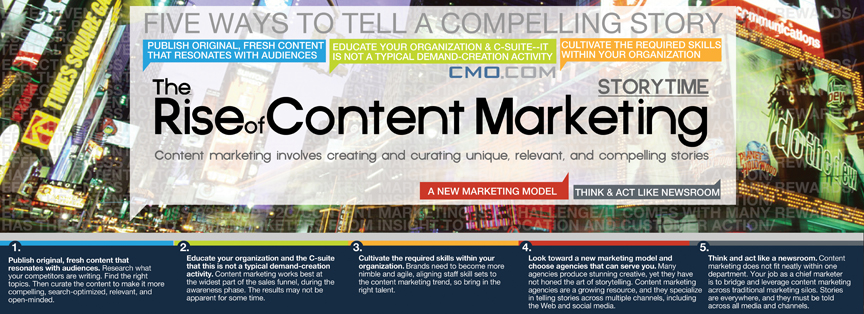Jay Kerger and Loni Stark provided an entertaining review of best practices for content marketing on the last of the Adobe Summit 2015. Marketers need to execute effective content strategies to deliver great customer experiences. That doesn’t mean creating more and more content, but rather it means creating better, more engaging and more intelligent content for your audience.

Everybody is in content marketing, whether you are a producer or consumer. Consumers have a choice of where to go for content so content marketers have to work hard to attract, nurture and retain audiences. Content saturation is a real problem today. There is so much content available in text, images and video that it’s hard to attract attention to your content. “More content is being created every 2 days in 2015 than has ever been created from the beginning of time”, says Google’s Eric Schmidt.
Here are some stats:
- 35% of businesses have a documented content strategy.
- 42% of business create content weekly.
- 55% will increase their content marketing spend this year.
In B2B:
- 70% of companies are creating content at a faster pace than even last year.
- 77% of companies create content at least monthly.
How to get better at content marketing? Having a content strategy is key. Here are top 5 best practices to follow:
- Focus on your audience. Instead of starting with the product or brand, start with the audience.
- Map content to sales cycle. If you focus on your product, you develop content for the top of the sales funnel. As you look at your audience, you will understand that as customers travel through the sales process, they want content specific to their needs at that time.
- Create personalized content. Personalization is not just adding the customer name at the top of an email or letter. A challenge to personalized content is to create the right structure of the content to make it personalizable.
- Promote content. We used to just create content like a white paper and maybe send an email to drive customers to that content. Now you want to create that content and then proliferate that content into different channels. For example, turn the content into an infographic that can be added to a blog. Tweet segments of the content with links back tot he original. Provide contests to access the content.
- Measure, Analyze and Optimize content. 70% of organizations still struggle with content measurement. They struggle with tying(attribute) content reading back to sales goals or other KPIs. However, to optimize your content, you must measure it and analyze what’s good, what’s bad,e tc.
One aspect of a content strategy is to have content governance. This should be a formal set of rules and processes to make sure content is produced and delivered appropriately. However, don’t make these governance rules into roadblocks, but rather provide guard rails. Governance requires participation by everyone in the organization. Content should be part of the culture and subject matter experts should be called upon to be key content contributors.
How to enable better content marketing using Adobe Experience Manager:
- Annotations in Adobe Experience Manager is a good way to enhance content. Peers can review the content and make comments right in the content using Annotations.
- Structure content so it can be reused easily
- Tag content for the audiences that would be interested in the content
- Data quality rules enable the rest of the organization. We usually think of data quality in relation to enterprise databases. This same quality should apply to content. Meta data on content increase search ability and decrease duplication. Within AEM you can automate Data Checks in the approval workflow to make sure meta data is getting filled in appropriately.
How to create engaging content:
- First, make the content relevant. Check to see if your content answers a key question that keeps a customer up at night.
- Have a new or unexpected perspective. What are you saying different from everyone else.
- Tell a story and connect your content to that story. This helps create an emotional connection with you.
- Make sure the content is useful. Can the customer do something new or think differently.
What makes content Intelligent?
- Semantic organization helps the customer understand where the content fits in the overall picture
- Rich Structure
- Findability
- Reusability across channels, screens and devices
- Deliverability
You typically judge intelligence by metrics. So intelligent content requires good data so measurements can be made. This data is also tremendously useful for personalization.
